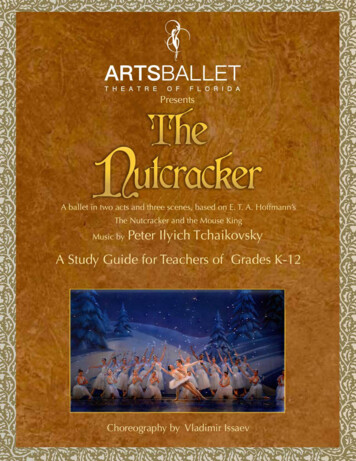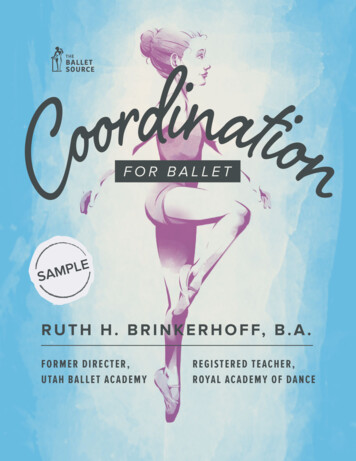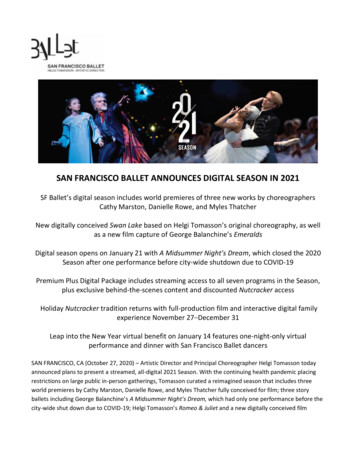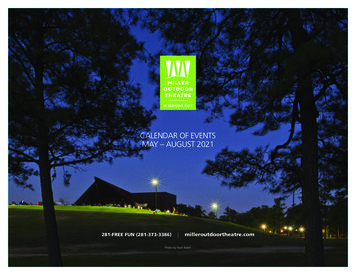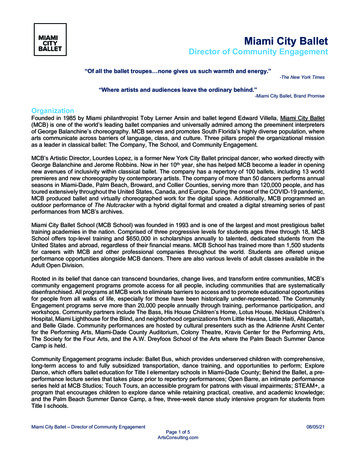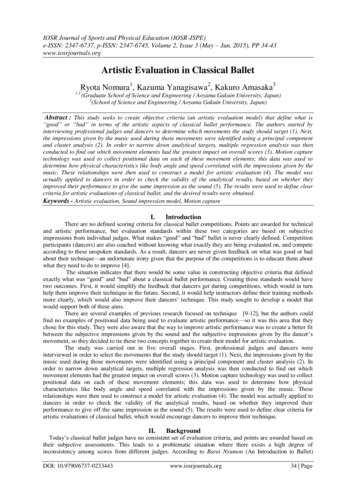
Transcription
IOSR Journal of Sports and Physical Education (IOSR-JSPE)e-ISSN: 2347-6737, p-ISSN: 2347-6745, Volume 2, Issue 3 (May – Jun. 2015), PP 34-43www.iosrjournals.orgArtistic Evaluation in Classical BalletRyota Nomura1, Kazuma Yanagisawa2, Kakuro Amasaka31,2(Graduate School of Science and Engineering / Aoyama Gakuin University, Japan)3(School of Science and Engineering / Aoyama Gakuin University, Japan)Abstract : This study seeks to create objective criteria (an artistic evaluation model) that define what is“good” or “bad” in terms of the artistic aspects of classical ballet performance. The authors started byinterviewing professional judges and dancers to determine which movements the study should target (1). Next,the impressions given by the music used during those movements were identified using a principal componentand cluster analysis (2). In order to narrow down analytical targets, multiple regression analysis was thenconducted to find out which movement elements had the greatest impact on overall scores (3). Motion capturetechnology was used to collect positional data on each of these movement elements; this data was used todetermine how physical characteristics like body angle and speed correlated with the impressions given by themusic. These relationships were then used to construct a model for artistic evaluation (4). The model wasactually applied to dancers in order to check the validity of the analytical results, based on whether theyimproved their performance to give the same impression as the sound (5). The results were used to define clearcriteria for artistic evaluations of classical ballet, and the desired results were obtained.Keywords - Artistic evaluation, Sound impression model, Motion captureI.IntroductionThere are no defined scoring criteria for classical ballet competitions. Points are awarded for technicaland artistic performance, but evaluation standards within these two categories are based on subjectiveimpressions from individual judges. What makes ―good‖ and ―bad‖ ballet is never clearly defined. Competitionparticipants (dancers) are also coached without knowing what exactly they are being evaluated on, and competeaccording to these unspoken standards. As a result, dancers are never given feedback on what was good or badabout their technique—an unfortunate irony given that the purpose of the competitions is to educate them aboutwhat they need to do to improve [4].The situation indicates that there would be some value in constructing objective criteria that definedexactly what was ―good‖ and ―bad‖ about a classical ballet performance. Creating these standards would havetwo outcomes. First, it would simplify the feedback that dancers get during competitions, which would in turnhelp them improve their technique in the future. Second, it would help instructors define their training methodsmore clearly, which would also improve their dancers’ technique. This study sought to develop a model thatwould support both of these aims.There are several examples of previous research focused on technique [9-12], but the authors couldfind no examples of positional data being used to evaluate artistic performance—so it was this area that theychose for this study. They were also aware that the way to improve artistic performance was to create a better fitbetween the subjective impressions given by the sound and the subjective impressions given by the dancer’smovement, so they decided to tie these two concepts together to create their model for artistic evaluation.The study was carried out in five overall stages. First, professional judges and dancers wereinterviewed in order to select the movements that the study should target (1). Next, the impressions given by themusic used during those movements were identified using a principal component and cluster analysis (2). Inorder to narrow down analytical targets, multiple regression analysis was then conducted to find out whichmovement elements had the greatest impact on overall scores (3). Motion capture technology was used to collectpositional data on each of these movement elements; this data was used to determine how physicalcharacteristics like body angle and speed correlated with the impressions given by the music. Theserelationships were then used to construct a model for artistic evaluation (4). The model was actually applied todancers in order to check the validity of the analytical results, based on whether they improved theirperformance to give off the same impression as the sound (5). The results were used to define clear criteria forartistic evaluations of classical ballet, which would encourage dancers to improve their technique.II.BackgroundToday’s classical ballet judges have no consistent set of evaluation criteria, and points are awarded based ontheir subjective assessments. This leads to a problematic situation where there exists a high degree ofinconsistency among scores from different judges. According to Barei Nyumon (An Introduction to Ballet)DOI: 10.9790/6737-0233443www.iosrjournals.org34 Page
Artistic Evaluation in Classical Balletpublished by Miura in 2000, technical and artistic performance is basically scored according to the followingfive elements; however, there is room for interpretation in each and no clear definition of what is ―good‖ or―bad‖ is given.i.Ability to understand and express the variation: Understanding the part and expressing it wellii.Appearance: Articulation and openness of the hip jointsiii. Musicality: Correct musical expression, rhythm, and keeping in time with the musiciv. Technique: Correct performance of each movement, positioning, rotation, jumping, balance, etc.v.Potential: Likelihood that the dancer will be able to make a name for themselves with continued growthand practiceThe evaluation of artistic performance in particular is wholly dependent on the subjective impressionsof each judge, and differences of opinion make it impossible to give dancers clear feedback on what they needto do in the future. Because there is no single set of criteria on what constitutes a ―good‖ or ―bad‖ performance,classical ballet faces a problematic situation where the competitions that are supposed to serve as educationalopportunities (a chance for dancers to improve their technique) fall short of their intended goals.There is some meaning, therefore, in creating a set of valid evaluation criteria that define what is goodand what is bad in terms of artistic evaluations. It was hoped that constructing these artistic evaluation criteriawould help (1) create a competition environment where it is easy to give dancers feedback, (2) set up a classicalballet learning environment that is structured to facilitate coaching, and (3) improve the artistic performance ofindividual dancers.Through interviews with professional judges, the authors learned that the degree to which theimpressions created by the dancers’ movements matched the feel of the music had a significant impact on thelevel of artistic performance. Given this fact, the study sought to identify the subjective impressions created bycertain sounds and use it to specify the subjective impressions that classical ballet dancers should create throughtheir range of movement. These two sets of data would then be brought together in order to construct theauthors’ model for evaluating artistic performance in classical ballet.III.Selecting A Performance For AnalysisThe authors conducted interviews in order to determine the analytical targets for their study. Based onthe results, they decided on three key factors that should be used to select the most practical movements: (1) themovements should be practical as they are used in international competition, (2) the movements should includeseveral movement elements as well as lateral movement, and (3) the movements should be strongly tied to thesubjective feel of the music as well as the choreographic story. These factors were then used to select a danceperformance.When the study was proposed to the Prix de Lausanne international dance competition, the authorsfound that the choreography for The Flower Festival in Genzano used in their 2009 competition was anoutstanding choice of subject in terms of the factors listed above. The part of the ballet selected was furthernarrowed down based on the following considerations: (1) the need for a one- or two-minute performance thatmimicked competition conditions, (2) the portion of The Flower Festival in Genzano with the most emotionalexpressiveness, and (3) the need for the choreography of the excerpt to contain multiple movement elements.IV.Analyzing Subjective Impressions Of Sound4.1 Identifying trends in sound structureThe score for the The Flower Festival in Genzano piece used in this study consists of 43 total measures.The music was broken down into individual measures and then further into 8 sounds per measure. Each soundwas then numerically represented based on frequency. The calculations were done using the MIDI TuningStandard developed by Scholz in 1991[3]. Then, since it was assumed that the subjective impression given byany sound was affected by the previous sound, the difference in the frequencies of the two sounds wascalculated and collected as data. In addition, the presence of musical symbols (staccato, tenuto, slurs) was usedas a dummy variable and converted into data as well.The authors then subjected the data collected to a principal component analysis and cluster analysis inorder to identify patterns in the sound structure. The groupings found through the cluster analysis as well as thecomponent axes and principal component scores from the principal component analysis were compared withone another (Figure 1). This allowed the authors to define six clusters: (1) rising tone/intermittent, (2) fallingtone/intermittent, (3) major change/intermittent, (4) sustained first note, (5) ties, and (6) rests. The authors werethus able to identify six trends in sound structure (Figure 2)DOI: 10.9790/6737-0233443www.iosrjournals.org35 Page
Artistic Evaluation in Classical BalletFig.1 Principal component analysis and cluster analysisFig.2 The six sound structures4.2 Subjective impressions created by the sound structureNext, sensory words were used in order to determine the subjective impression created by each of thesix sound structures. Test subjects were asked to listen to the music of The Flower Festival in Genzano and rateeach phrase on a seven-point scale. Fourteen sensory words were used for the study: natural, happy, lonely,dynamic, solemn, flowing, sharp, exquisite, vivid, beautiful, clear, powerful, majestic, and exhilarating [1-2].The authors prepared subjective impression questionnaires for each type that included the 14 sensorywords and gave them to eleven professional judges and 33 members of the general public (which included thoseinvolved in ballet) for a total of 44 subjects.The authors then used this data to compare partial correlation coefficients and identify the causalrelationships between each cluster and sensory word. Items that score 0.6 or above were assigned a , thosebetween 0.4 and 0.6 were assigned a , and those between 0.2 and 0.4 were assigned a . Those with a scorebetween 0.2 and –0.2 were marked with a triangle, while negative correlations between –0.2 and –0.4 weregiven a -, those between –0.4 and –0.6 were given a - - and those of less than –0.6 were given a - - - (Table 1).The items with a ranking or above were judged to be sensory words with a strong correlation to theirrespective clusters, and were built into the sound impression model for the purposes of artistic evaluations(Figure 3).DOI: 10.9790/6737-0233443www.iosrjournals.org36 Page
Artistic Evaluation in Classical BalletTable.1 Relationships between each cluster and sensory wordFig.3 The sound impression modelV.Analysis Of Movements Expressing Each Subjective Impression5.1 Identifying the importance of each movement elementThe authors identified which movement elements were most critical to the movements from TheFlower Festival in Genzano performance used in this study. Based on the results of their interviews and keepingcontinuity of movement in mind, the authors were able to break The Flower Festival in Genzano into sevenmovement segments, which they labeled A through G. Part A was preparation; Part B was repeated port de bras,brisé, and coupe; Part C was repeated endehors and pas de bourree; Part D was repeated arabesque, à la seconde,and pique arabesque; Part E was pas de bourree and jete; Part F was a rond de jambe; and Part G was the croisépose. The authors used these subdivisions to identify which movement segments had the greatest effect onoverall scores, and then used those weights to determine which movements would be the subject of theremainder of the analysis as well as their relative priority.A total of six judges were asked to evaluate the movements of nine dancers on a 100-point scale aswell as assign an overall score (Table 2). The weight of each movement in the overall results was subjected to amultiple regression analysis to determine the standard partial regression coefficients. The analysis revealed astandard partial regression coefficient for pattern D that was larger than those of the other segments (see figure4), leading the authors to determine that it should be the area given top priority in the remainder of the study.DOI: 10.9790/6737-0233443www.iosrjournals.org37 Page
Artistic Evaluation in Classical BalletTable.2 The score every segment and overall scoreFig.4 The weight of segments in the overall scores5.2 Determining movement factors based on visual focus timeLine-of-sight cameras were used for pattern D in order to measure how long viewers focused on eachpart of the body, which allowed the authors to identify the movement factors that contributed most to judges’scores. Three professional judges participated in the study, and the degree to which they rested their eyes onvarious parts of the body was calculated.Markers were placed at 38 locations on the body to collect movement information along three axes [9].Lateral body movement was represented on the x-axis, forward and back body movement on the y-axis, and upand down body movement on the z-axis. This positional data was then used to calculate values for eachmovement factor and compare the result.DOI: 10.9790/6737-0233443www.iosrjournals.org38 Page
Artistic Evaluation in Classical BalletFig.5 Visual focus time in pattern D5.3 Subjective impressions for each movement elementThis step will be explained using the à la seconde movement as an example. For the purposes of artisticevaluation, the sound impression model tells us that the à la seconde should evoke the same subjectiveimpressions as those identified during the subjective sound impression model; namely, happy, majestic, sharp,clear, and powerful. Judges were asked to subjectively evaluate the nine dancers based on information collectedfrom just the à la seconde, and then partial correlation coefficients were used to compare the relationshipbetween the sensory words and the dancers. For each sensory word, the dancer with the strongest correlation,second-strongest correlation, weakest correlation, and second-weakest correlation for the movement factor wasidentified (Table 3).Table.3 The relationship between the sensory words and 49Dancer 7 and Dancer 1 expressed ―happy‖ most strongly, while Dancer 8 and Dancer 1 were theweakest in that expression. Within the movement factor, the data revealed a characteristic difference in the waythe angle of the right knee changed between the high and low scorers.It was noted that Dancer 7 and Dancer 1 showed a rapid decrease in knee angle and increase in speedduring the middle of the pattern (frames 50–111) (Figure 6). Cleanly bending the right knee to almost 80ºseemed to be the key to creating a ―happy‖ impression.Dancer 5 and Dancer 7 expressed ―magnificent‖ most powerfully, while Dancer 6 and Dancer 8 werethe weakest in that expression. Within the movement factor, the data revealed a characteristic difference in thespeed gap between the right wrist and right fingertips.DOI: 10.9790/6737-0233443www.iosrjournals.org39 Page
Artistic Evaluation in Classical BalletFig.6 The change in the angle of right kneeIt was noted that the right wrist of Dancer 5 and Dancer 7 moved faster than the right toes during thebeginning of the pattern (frames 0–56), with the speed of the toes overtaking that of the wrist during the middleportion (frames 57–122) as the feet led the movement of the hands. During the end of the pattern (frames 123–179), the speed of the right wrist once again increased beyond that of the right toes, this time in the form of thehands leading the feet (Figure 7). This relationship between the speed of the right wrist and right toes—acceleration of the hand during the beginning, acceleration of the foot during the middle, and acceleration of thehand once again at the end—seemed to be the key to creating a ―magnificent‖ impression.Similarly, as soon as the authors understood the movement factor conditions that correlated moststrongly to each sensory word during the arabesque, à la seconde, and pique arabesque, they were able to createa table showing the elements that most contributed to scores during evaluations of The Flower Festival inGenzano (Table 4).Fig.7 The speed gap between the wrist and fingertipsDOI: 10.9790/6737-0233443www.iosrjournals.org40 Page
Artistic Evaluation in Classical BalletTable 4. The artistic evaluation scoresIn terms of judging, the results of the study show what should be prioritized at one time in the course ofevaluations and allows for the introduction of a system that assigns scoring items for each of those points. Interms of teaching, the study reveals specific methods for evoking certain subjective impressions, which can betaught faithfully to dancers so that they can create more artistically expressive movements.VI.VerificationThe validity of the artistic evaluation table was verified using The Flower Festival in Genzano as anexample piece. Two methods were used, in which the model was applied again to the same dancers to measureany changes before and after its application. In the first method, ratings were quantified along a seven-pointscale in terms of the consistency with sensory words and subjective impressions, and changes before and afterthe introduction of the model were measured (1). In the second method, professional judges and dancers wereinterviewed about the evaluations produced by the model in order to shed light on the results (2).During the experiments, participating dancers were given a week to practice so that they couldincorporate the model into their performance. When the three judges were asked to evaluate them, the averagescores for each sensory word went up (Figure 8). The model was thus shown to have a high degree of validity.Then, when professional judges, dancers, and instructors were interviewed, the following feedback wasreceived: ―I felt like knowing exactly what is being focused on during previously inexplicit artistic performanceassessments made evaluation easier from a judging standpoint. The details were appropriate, and seemed closeto what we’re looking for. In terms of instructors, I think it would be extremely effective if we could tap furtherinto our dancers’ potential and improve their skills by giving them a single textbook that outlined theseconcepts.‖The above results confirmed that the authors were able to develop and offer a model that effectivelycaptured what classical ballet judges, instructors, and dancers need and want from each other.DOI: 10.9790/6737-0233443www.iosrjournals.org41 Page
Artistic Evaluation in Classical BalletFig.8 Before and after the introduction of the modelVII.ConclusionThere are no defined scoring criteria for classical ballet competitions, and dancers are never givenfeedback on what was good or bad about their performances. This is an unfortunate irony given that the purposeof the competitions is to educate participants so that they can improve their technique. This study saw somevalue in creating objective criteria to indicate exactly what was ―good‖ and ―bad‖ about a classical balletperformance and sought to develop these criteria.In step 1, the authors used a principal component analysis and cluster analysis to identify the subjectiveimpressions given by the music that accompanied the movements; this data was then used to construct a soundstructure model that could be used in artistic evaluations. This process made it possible to reduce the effortdancers previously needed to put into understanding the subjective impressions created by sound/music byspecifying exactly what impressions they should recreate and generalizing them for future use.In step 2, the analytical targets were narrowed down and movements were broken into individualelements. Multiple regression analysis was used to find which of those movement elements had the greatestimpact on overall scores. For each movement element, the authors looked at the relationships between thesubjective impressions given by the sounds and physical angle, speed, and other body movements calculatedusing positional information from motion capture equipment. This information was then used to construct theirartistic evaluation model.In step 3, the model was actually applied to dancers. Their performances were recorded and confirmedto see whether they danced in the way suggested by the model, and the effectiveness of the model was verifiedby confirming numerically that their ability to evoke subjective impressions had increased. Interviews withprofessional judges and dancers were then conducted, the results confirming that the study had value from bothan evaluation and teaching standpoint.It is hoped that the outcomes of this study can be used to simplify the feedback that dancers get after acompetition, helping them to improve their technique in future performances. It is also thought that clarifyingcoaching and teaching methods will improve dancer technique as well. In this way, the study achieved itsoriginal objectives and confirmed the value of its artistic evaluation model.DOI: 10.9790/6737-0233443www.iosrjournals.org42 Page
Artistic Evaluation in Classical ].[10].[11].[12].H. Asami, T. Ando, M. Yamaji and K. Amasaka ; A Study on Automobile Form Design Sup port Method ―AFD-SM‖,Journal of Business & Economics Research, 8(11), pp.13 -19, 2010.K. Koizumi, M. Muto and K. Amasaka; Creating Automobile Pamphlet Design Method: Utilizing Both Biometric Testing andStatistical Science, Journal of Management Research, 6(1), pp. 81-94, 2013.C. Scholz; A Proposed Extension the MIDI Specification Concerning Tuning, Computer Music Journal,15(1), pp.49-54, 1991.K. Yanagisawa and K. Amasaka; Constructing a Scoring Support Approach Model for Classical Ballet: Combing Motion Captureand Statistical Science, Journal of Business & Economics Research, 11(6), pp. 241-250, 2012.K. Amasaka, Science SQC, New Quality Control Principle, Springer, 2004.K. Amasaka, Science TQM, New Quality Management Principle, Bentham Science Publishers, 2012.K. Amasaka, New JIT, New Management Technology Principle, Taylor & Francis, 2014.Y. Iino and T. Moriya, T. Takahashi; Motion Analysis of Street Dance performance and its Applications for Instructional Coaching,The Institute of Image Information and Television Engineers, 35(14), pp. 49-52, 2011.S. Kudoh, T. Komura and K. Ikeuchi; Modeling Balance with Whole-body Motion Based on Observation of Human Motion, The 8 thMeeting on Image Recognition and Understanding, 2005.[10] A. Soga and B. Umino; Creative Simulation by Analyzing Choreographic elements of Classical Ballet, Information ProcessingSociety of Japan, 100, pp. 45-52, 2008.[11] M. Tadenuma et al; Support for Image Transmission by Back-Ground Image and Music when Dancing, IEICE TechnicalCommittee, 102(191), pp. 25-30, 2002.[12] S. Noji; A Study of Emotion-oriented Ballet Arm Motion, Shob.DOI: 10.9790/6737-0233443www.iosrjournals.org43 Page
The results were used to define clear criteria for artistic evaluations of classical ballet, and the desired results were obtained. Keywords - Artistic evaluation, Sound impression model, Motion capture I. Introduction There are no defined scoring criteria for classical balle
